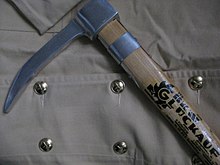Pickaxe
This article needs additional citations for verification. (July 2012) |
 Pickaxe on the ground | |
| Other names | Pick, pickax |
|---|---|
| Classification | Digging tool |
| Types | Railroad pick, miner's pick |
| Related | Mattock |

A pickaxe, pick-axe, or pick is a generally T-shaped
A standard pickaxe, similar to a "pick mattock", has a pointed end on one side of its head and a broad flat "axe" blade opposite. A gradual curve characteristically spans the length of the head. The next most common configuration features two spikes, one slightly longer than the other.
The pointed end is used both for breaking and prying, the axe for hoeing, skimming, and chopping through roots.
Developed as
Etymology
The Oxford Dictionary of English states that both pick and pickaxe have the same meaning, that being a tool with a long handle at right angles to a curved iron or steel bar with a point at one end and a chisel or point at the other, used for breaking up hard ground or rock.[1]
The term pickaxe is a folk etymology alteration of Middle English picas via Anglo-Norman piceis, Old French pocois, and directly from Medieval Latin picosa 'pick', related to Latin picus 'woodpecker'.[2][3] Though modern picks usually feature a head with both a pointed end and an adze-like flattened blade on the other end, current spelling is influenced by axe, and pickaxe, pick-axe, or sometimes just pick cover any and all versions of the tool.
History
In prehistoric times a large shed
As a weapon

The historic pickaxe was readily adapted to a weapon for hand-to-hand combat in ancient times. Over the centuries aspects of it were incorporated in various battle axes.
A pickaxe handle (sometimes called a "pickhandle" or "pick helve") is sometimes used on its own as a club for bludgeoning. In The Grapes of Wrath by John Steinbeck, pick handles were used against migrant farmers, and Georgia governor Lester Maddox famously threatened to use a similar, more slender axe handle to bar blacks from entering a whites-only restaurant in the heated days of the American civil rights movement of the 1960s. A pick handle is officially used as a baton in the British Army.[citation needed]
Pickaxes are commonly carried by
A normal pickaxe handle is made of
- With a plastic casing on the thick end.
- Made of carbon fibre[citation needed]
They are sometimes made with a steel casing on the thick end.
See also
References
- ISBN 978-0-19-861057-1.
- ^ "Pickax". Merriam-Webster.com Dictionary. Retrieved 2017-03-03.
- ^ Harper, Douglas. "pickaxe". Online Etymology Dictionary.
- ^ "Deer-antler pick, used in flint mining from Grimes Graves". ingenious.org.uk. Retrieved 6 July 2012.
- ^ Tooth, John-Paul (3 October 2018). "Meet The Pioneer Sergeant: One Of The Few Army Ranks Allowed A Beard On Parade" (Web page). forces.net. p. 1. Retrieved 22 July 2019.
